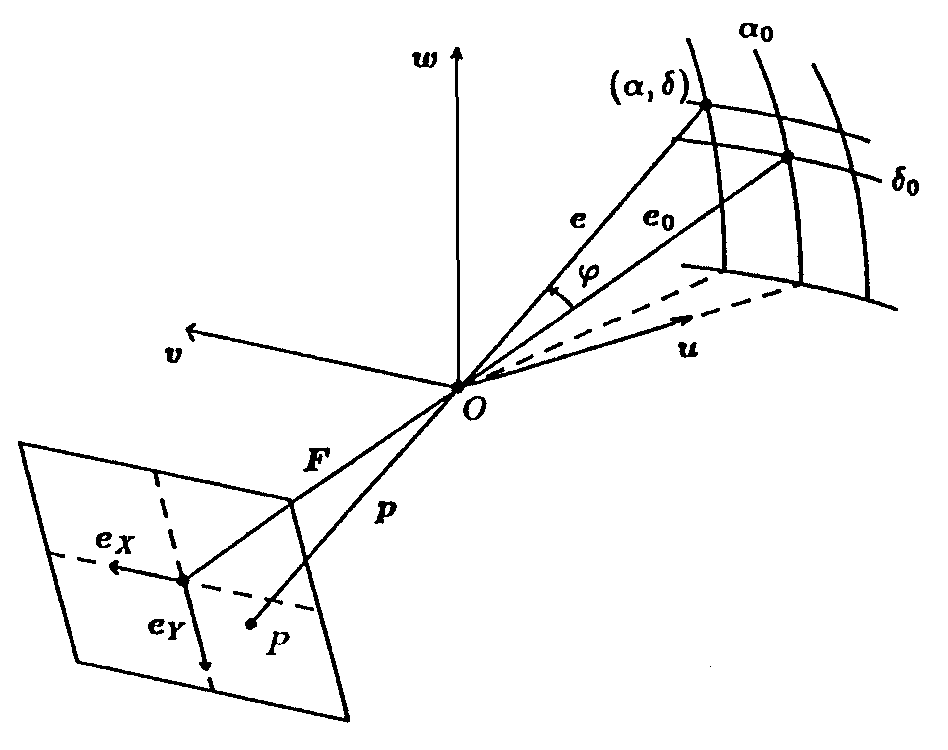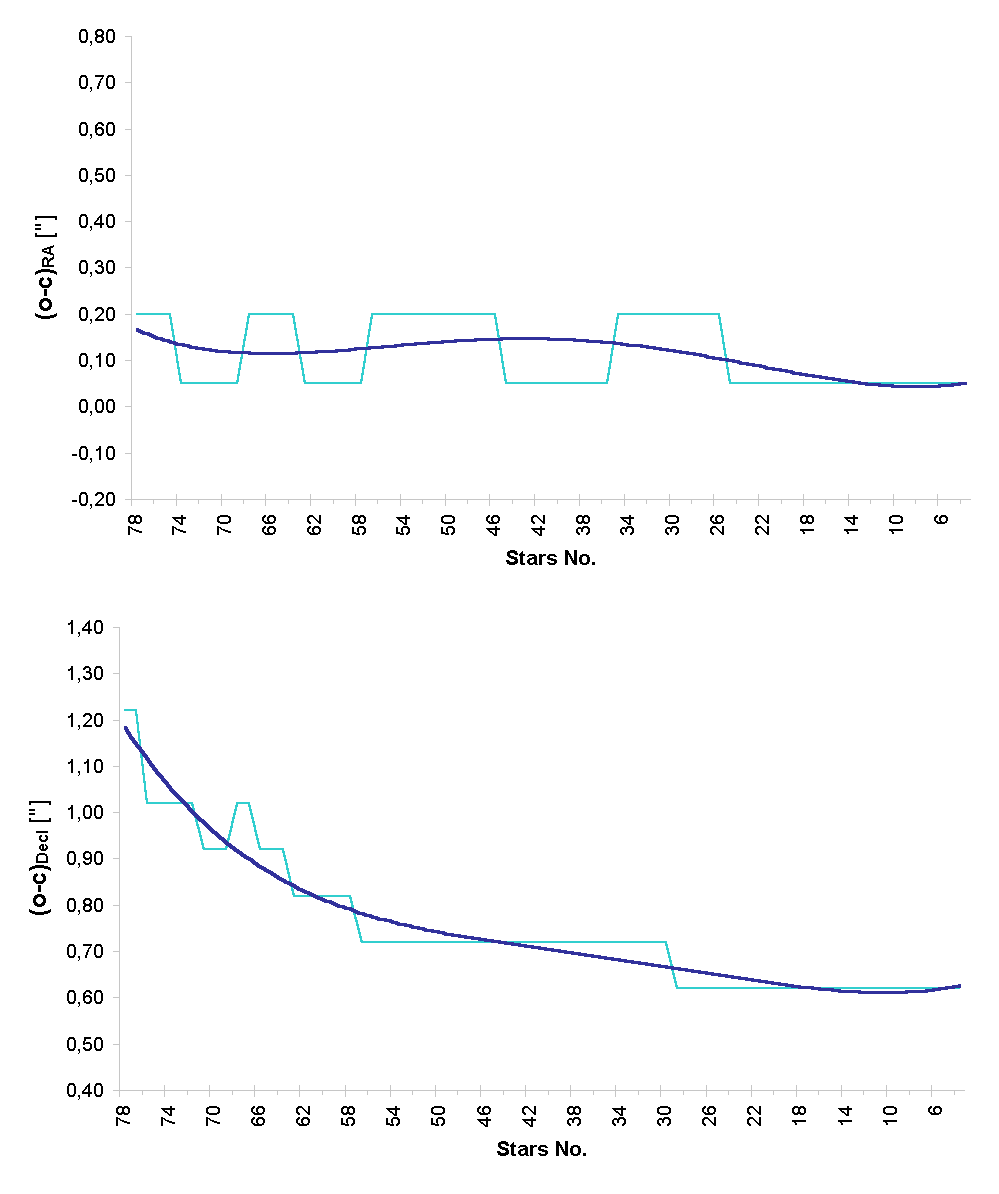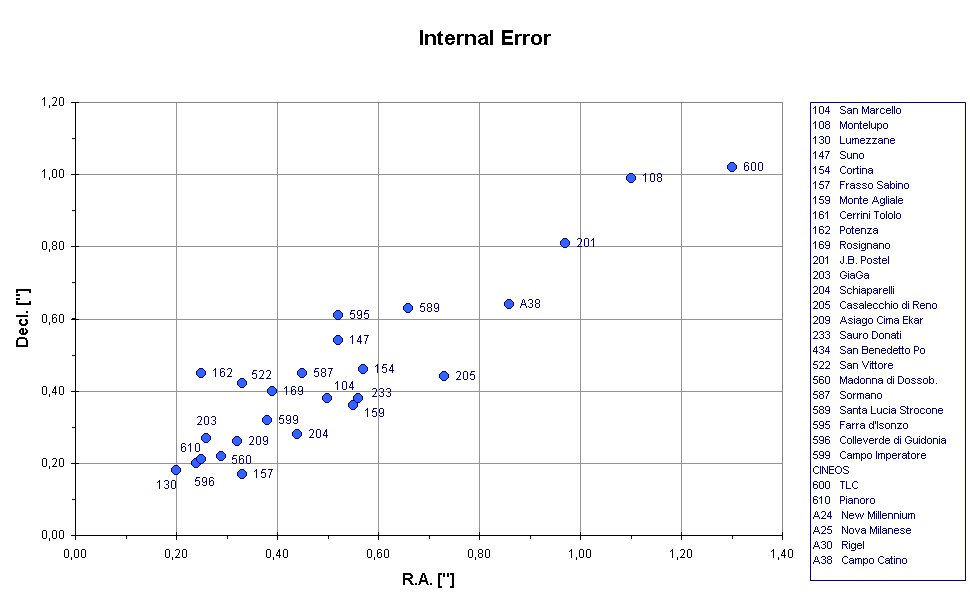
Improving accuracy of astrometric observations using plate constants method
Sergio Foglia
Serafino Zani Astronomical Observatory, Lumezzane, Italy
F. Bisleri 11, I-20148 Milano, Italy, s.foglia@libero.it
Gianpaolo Pizzetti
Serafino Zani Astronomical Observatory, Lumezzane, Italy
A.Volta 22, I-25028 Verolauova BS, Italy, pg.soft@tin.it
Abstract:
a recurrent plate constants method for astrometric reduction is suggested. Thanks to the availabilty of detailed stars’ catalogues such as USNO A-2.0 we are able to find tents of reference stars in a field of only 0.5 degrees. It is possible to improve accuracy in the astrometric observations using only a limited set of reference stars: whose that give the little values of residuals appling the least squares method in the plate contants astrometric reduction. Several tests are shown and the accuracy of astrometric measurements was improved.
Introduction
Least squares method in the plate contants astrometric reduction is well known: it needs at least four reference stars and it is possible to compute residuals for each reference star. Availabilty of detailed stars’ catalogues such as USNO A-2.0 increases a lot the number of references stars: in fact we usually find many tents of stars listed in a selected sky region with an amplitude of only 0.5 degree. It is well known also that accuracy in astrometric measurements is given by a combination of the following factor: atmosphere, telescope, CCD, star catalogue.
Plate Constant Metod (PCM)
Plate Constant Method (PCM) is well known in astrometric measurements. PCM computes position in R.A. and Decl. of a target from known positions of almost four stars simply measuring the relative coordinates of all involved objects. six parameter were computed to transforme the measured relative coordinates (x,y) to celestial positions (R.A., Decl.), the so called plate constants. Appling PCM we obtain celestial positions and residuals for each object. Fig. 1 show geometrically the function of PCM

figure 1: plate constant method
Recurrent Plate Constant Metod (RPCM)
It is possible to improve accuracy in the astrometric observations using only a limited set of reference stars: whose that give the little values of residuals appling the least squares method in the plate contants astrometric reduction, we call this procedure recurrent plate contants method (RPCM). Pratically we apply the following scheme:
A recurrent approach to the previous points 2 and 3 is applied until the set of mean values of residuals converge or if there are only four reference’s star.
Discussion
We’ve performed several tests to know how RPCM is efficient. First test involve astrometric reduction of one reference star as a target object. Eleven reference stars were involed in this test and results are shown in the table 1: appling RPCM the mean values for differences are the following:
D
R.A. = 0.094" ± 0.064" = 0.094" ± 0.064" DDecl. = 0.164" ± 0.102"while appling the traditional method (called PCM, plate constants method) the mean values for differences are:
D
R.A. = 0.266" ± 0.148" = 0.266" ± 0.148" DDecl. = 0.504" ± 0.252"|
USNO A-2 |
RPCM |
PCM |
RPCM |
PCM |
|||||||||||||
|
Star |
R.A. (J2000) |
Decl (J2000) |
Mag |
Mag |
R.A. |
Decl |
R.A. |
Decl |
D AR |
D Decl |
D AR |
D Decl |
|||||
|
hh |
mm |
ss.sss |
° |
‘ |
" |
B |
R |
Rif |
ss.ss |
" |
ss.ss |
" |
" |
" |
" |
" |
|
|
0900-05590130 |
7 |
57 |
52.353 |
0 |
35 |
16.00 |
13.6 |
12.9 |
605 |
52.35 |
15.6 |
52.34 |
15.6 |
0.045 |
0.400 |
0.195 |
0.400 |
|
0900-05589917 |
7 |
57 |
51.569 |
0 |
33 |
28.48 |
15.5 |
14.2 |
605 |
51.56 |
28.6 |
51.55 |
28.6 |
0.135 |
0.120 |
0.285 |
0.120 |
|
0900-05586611 |
7 |
57 |
39.549 |
0 |
37 |
11.12 |
15.7 |
15.1 |
605 |
39.56 |
11.2 |
39.57 |
11.8 |
0.165 |
0.080 |
0.315 |
0.680 |
|
0900-05586072 |
7 |
57 |
37.510 |
0 |
31 |
13.50 |
15.7 |
15.3 |
605 |
37.51 |
13.6 |
37.53 |
13.8 |
0.000 |
0.100 |
0.300 |
0.300 |
|
0900-05589475 |
7 |
57 |
49.860 |
0 |
32 |
30.87 |
16.9 |
15.4 |
605 |
49.87 |
30.9 |
49.86 |
30.8 |
0.150 |
0.030 |
0.000 |
0.070 |
|
0900-05585516 |
7 |
57 |
35.394 |
0 |
36 |
18.21 |
16.0 |
15.6 |
605 |
35.40 |
18.0 |
35.41 |
18.7 |
0.090 |
0.210 |
0.240 |
0.490 |
|
0900-05583740 |
7 |
57 |
29.015 |
0 |
31 |
13.33 |
15.9 |
15.7 |
605 |
29.01 |
13.0 |
29.05 |
14.4 |
0.075 |
0.330 |
0.525 |
1.070 |
|
0900-05587356 |
7 |
57 |
42.135 |
0 |
33 |
46.53 |
16.9 |
15.7 |
605 |
42.14 |
46.7 |
42.15 |
47.3 |
0.075 |
0.170 |
0.225 |
0.770 |
|
0900-05591064 |
7 |
57 |
55.844 |
0 |
32 |
26.56 |
16.4 |
15.9 |
605 |
55.84 |
26.8 |
55.86 |
27.3 |
0.060 |
0.240 |
0.240 |
0.740 |
|
0900-05585614 |
7 |
57 |
35.758 |
0 |
33 |
11.59 |
16.8 |
16.1 |
605 |
35.77 |
11.4 |
35.79 |
12.1 |
0.180 |
0.190 |
0.480 |
0.510 |
|
0900-05588830 |
7 |
57 |
47.431 |
0 |
37 |
14.95 |
16.7 |
16.1 |
605 |
47.43 |
15.0 |
47.42 |
15.2 |
0.015 |
0.050 |
0.165 |
0.250 |
|
0900-05584176 |
7 |
57 |
30.541 |
0 |
30 |
43.05 |
16.5 |
16.2 |
605 |
30.53 |
42.9 |
30.56 |
43.6 |
0.165 |
0.150 |
0.285 |
0.550 |
|
0900-05584231 |
7 |
57 |
30.714 |
0 |
34 |
31.27 |
16.3 |
16.2 |
605 |
30.71 |
31.1 |
30.73 |
31.9 |
0.060 |
0.170 |
0.240 |
0.630 |
|
0900-05584502 |
7 |
57 |
31.807 |
0 |
31 |
47.43 |
14.6 |
14.2 |
605 |
31.82 |
47.4 |
31.84 |
47.9 |
0.195 |
0.030 |
0.495 |
0.470 |
|
0900-05586616 |
7 |
57 |
39.560 |
0 |
36 |
39.49 |
13.9 |
13.3 |
605 |
39.56 |
39.3 |
39.56 |
40.0 |
0.000 |
0.190 |
0.000 |
0.510 |
Table 1: astrometric reduction of reference’s stars
Second test involve the (O-C) values performed using EPOS software of Pulkovo Observatory through the steps of the RPCM; they are shown in fig. 2: first step (78 reference stars) gives the following (O-C) values:
(O-C)R.A. = 0.20" (O-C)Decl. = 1.22"
And the last step (4 reference stars) gives:
(O-C)R.A. = 0.05" (O-C)Decl. = 0.62"

Figure 2: (O-C) values for RPCM steps
Final test involve the (O-C) values computed using EPOS software of Pulkovo Observatory for several astrometric measurements of numbered minor planet obtained by Lumezzane (MPC 130); RPCM gives (O-C) values less than PCM in the most of measurements as shown in the tab. 2.
|
MP |
Positions |
RPCM |
PCM |
||
|
R.A. [‘’] |
Decl. ["] |
R.A. [‘’] |
Decl. ["] |
||
|
433 |
4 |
0,273± 0,075 |
0,585± 0,100 |
0,180± 0,032 |
1,010± 0,112 |
|
1620 |
3 |
0,117± 0,074 |
0,440± 0,078 |
0,247± 0,097 |
0,673± 0,054 |
|
1627 |
4 |
0,255± 0,206 |
0,215± 0,075 |
0,218± 0,189 |
0,440± 0,117 |
|
1943 |
4 |
0,255± 0,282 |
0,430± 0,207 |
0,473± 0,590 |
0,605± 0,446 |
|
3103 |
4 |
0,348± 0,142 |
0,230± 0,127 |
0,413± 0,163 |
0,555± 0,266 |
|
65470 |
1 |
0,060 |
0,200 |
0,360 |
0,500 |
|
4660 |
3 |
0,390± 0,250 |
0,287± 0,054 |
0,243± 0,148 |
0,687± 0,083 |
|
8567 |
3 |
0,443± 0,189 |
0,457± 0,127 |
0,643± 0,074 |
0,757± 0,173 |
Table 2: (O-C) values for several minor planets
Figure 3 shows the error in astrometric measurements computed in Pulkovo Observatory for Italian observatories: proudly we seen that MPC 130 has the little values; it would be due to the RPCM method performed in 1999 by the authors and included in the astrometric reduction of the CCDIMG computer program.

Figure 3: error of astrometric measurements for Italian observatory
Conclusion
All measurements were made using CCDIMG computer program that include the RPCM for the astrometric reduction; interested observers will find this program on the Web (see bibliography).
It seems that RPCM works better than PCM and we hope that RPCM will be included in the most known computer program for astrometric reduction.
Is also known that error propagation says that the error on the final solution is given by the formula:
![]()
where d is the mean residual of all reference stars, and n is the number of stars used.
For the USNO-A catalogue mean residual is 0.3", thus if we have 100 reference’s stars final uncertainty is 0.03". By using more stars, we also have a smaller risk of introducing a systematic error (for example, the proper motions, which are not given in the USNO-A catalogue, will average out by using a large number of stars). Observers know that due to accidental and systematic errors such as blooming, double stars, hot pixel, proper motion and so on, the number of reference stars that should be involved in the reduction is less.
The best solution would probably be to use a new, improved star catalogue, like the USNO-B or the UCAC2. Besides providing more precise stellar positions than the USNO-A2.0, these catalogs provide proper motions, and have much smaller systematic errors over the whole sky; in this case RPCM do not works better than PCM.
Acknowledgements
We would like to thank Oleg P. Bykov, Victor N. L’vov , Igor S. Izmailov of Pulkovo Astronomical Observatory (St. Petersburg, Russia) and Nina K. Sumzina of Institute of Applied Astronomy (St. Petersburg, Russia) for their valuable support computing (O-C) values using EPOS software.
Thank also to Herbert Raab (Linz, Austria) for the valuable suggestions.
Bibliography
Bykov O. P. et al.
Accuracy of Positional CCD Observations of Numbered Minor Planets in 1999-2001 yrs
Proceedings of the Conference Asteroids, Comets, Meteors 2002
European Space Agency SP-500, 2002
Bykov O. P.
Pulkovo Astronomical Observatory, St. Petersburg, Russia
private message
Montenbruck O., Pfleger T.
Astronomy on the Personal Computer
1989, Springer-Verlag
Pizzetti G.
CCDIMG
http://www.uai.it/sez_ast/english/
Raab H.
Linz, Austria
private message
USNO A-2 catalogue
United States Naval Observatory
Sergio FOGLIA,, Giampaolo PIZZETTI
Enter the forum and ask your questions to the author!